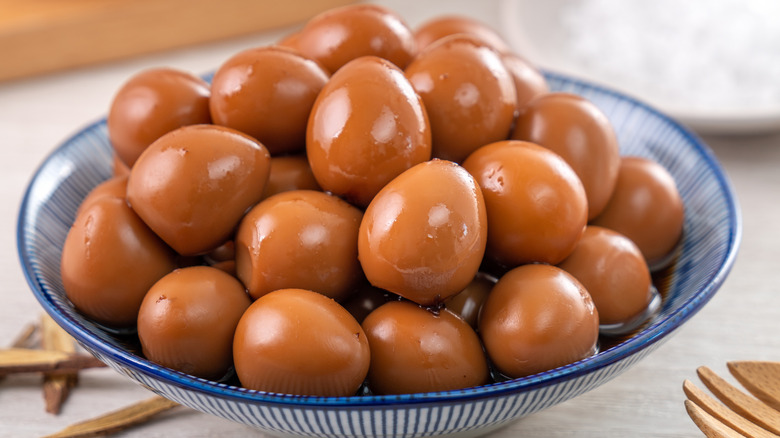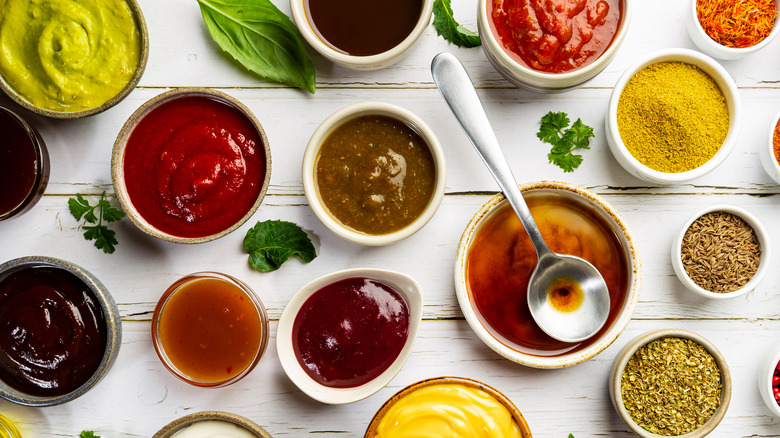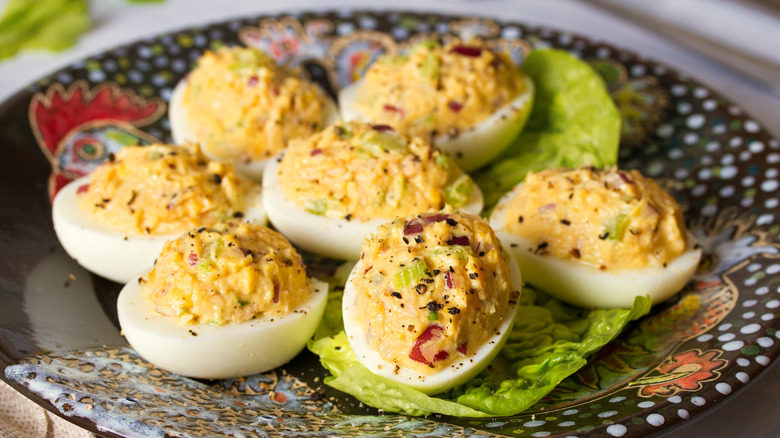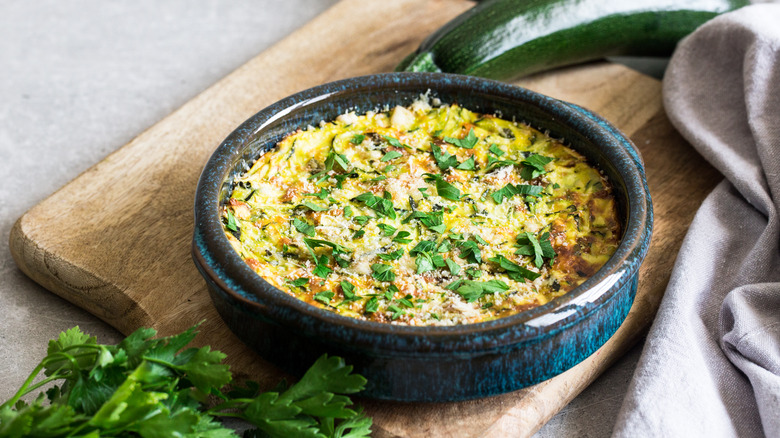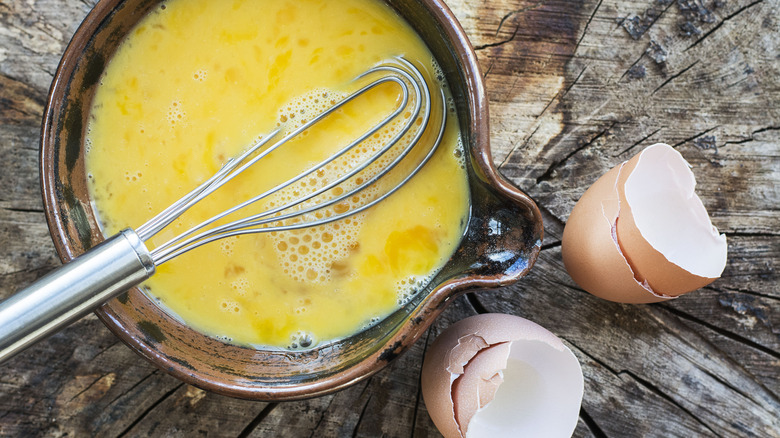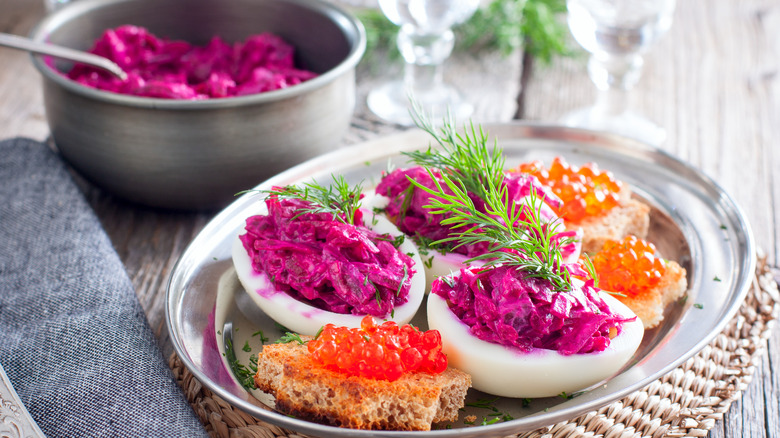The Ancient Roman History Of The Deviled Egg
Deviled eggs might seem like a fairly simple dish. After all, most deviled egg recipes are pretty easy to make. Just pop a dozen eggs into boiling water until they are hardboiled. Cool them, peel them, and halve them. Remove the cooked egg yolk and mash it together with some mayonnaise, mustard, and spices. Then, stuff the halved egg whites with the creamy, yolky mixture. Voilà: a platter of easy and delicious appetizers is ready to serve.
While the actual deviled egg cooking process is easy, the history behind the meal is much more complicated. Even though deviled eggs don't require many ingredients, chefs didn't develop the recipe overnight. On the contrary, cooks needed thousands of years to create the perfect combination of egg yolks, spices, and other ingredients.
The history of deviled eggs stems back to ancient Rome, although the Romans didn't prepare their eggs in the same ways that contemporary people do. According to the History Channel (via Alto Hartley), the ancient Romans enjoyed a rudimentary version of this popular recipe, which combined hardboiled eggs with spicy sauces. Although this old egg preparation method included several of the same ingredients as deviled eggs, the final result would have been much different. For example, the Romans did not deliberately stuff the egg whites with sauces in the way that chefs do now. Nonetheless, the original Roman recipe evolved over time until it became the deviled eggs that so many people enjoy today.
Ancient Romans loved to eat eggs
Well before anyone ever uttered the phrase "deviled egg," ancient Romans were enjoying all kinds of different egg recipes. In the wealthiest homes of the Roman empire, it was considered normal to serve eggs at the beginning of a banquet, according to the North Carolina Egg Association. In fact, eggs were such an important appetizer that the famous Roman writer, Horace, coined the Latin phrase "ab ovo usque ad mala," which translates to, "from eggs to apples." Per the Merriam-Webster dictionary, this saying refers to the upper-class Roman dinner custom of eating eggs as a starting course and enjoying apples for dessert.
Beyond the cultural value of eggs in ancient Rome, the food group possibly held a religious connotation. According to Smithsonian Magazine, ancient Romans viewed eggs as symbols of rebirth. They were likely used as religious offerings, and some people were even buried with them. In 2010, archaeologists even discovered the body of a young Roman boy, whose hand still clutched the chicken egg that someone had placed under his fingers prior to his burial.
Today, many of the ancient Roman traditions surrounding eggs have been forgotten. However, the ancient custom of eating eggs as appetizers continues to live on. To begin your dinners just like the Romans, start your meal with some egg dishes, like mini egg bites.
They also loved spicy sauces
If Romans adored eggs, they arguably loved spicy foods. One ancient Rome expert, Evan McDuff, has even pointed out that the Romans added spice to the vast majority of their meals. As McDuff noted in a piece for Brandeis University, "Three out of four recipes in a Roman cookbook call for it. Pepper, the king of spices, is one of the most influential spices in history." And, according to the ancient culinary studies specialist, the Romans didn't just use hot peppers in one or two of their favorite meals. Of the 468 different Roman foods that McDuff studied, approximately 351 of them contained the spicy ingredient. The researcher found that, ultimately, the food groups that called for pepper included everything from sauces to meats to even mulled wines. Inevitably, these sauces were also added to eggs.
To enjoy a little bit of the Roman tendency to spice up their meals, try making your own hot sauce. The hot sauce recipe from Puerto Rican chef Jose Enrique — who appeared on Food&Wine's Best New Chef list in 2013 — blends the ultra-spicy flavor of habanero peppers with the sweetness of red bell peppers to create a truly complex taste. To follow in the footsteps of the ancient Romans, add Enrique's hot sauce to your meat or eggs.
Romans frequently combined eggs and spices
Because the Romans enjoyed both eggs and spices, they often ate the two paired together. This tendency was detailed in the ancient Roman document, "De Re Coquinaria," which was likely written almost 2,000 years ago by a Roman chef named Apicius, according to Open Culture. In the translated version of the text (via Project Gutenberg), Apicius described several different combinations of hardboiled eggs and spicy sauces that are reminiscent of modern-day deviled eggs. One of his creations even included a spice-filled "white sauce," which he made using a similar method to the contemporary deviled egg cooking process.
To make this Roman version of white sauce, Apicius would begin by boiling eggs and removing the egg yolks. He would then mix the cooked egg yolks with white pepper, creating a paste, not unlike deviled egg filling. However, Apicius — and perhaps other Roman chefs — would not end the recipe there. Instead, they would also add nuts, honey, broth, and wine to the concoction. Ultimately, they would heat the mixture up and serve it over a pea and pork casserole.
This spin on spicy hardboiled eggs might sound compelling, but, unfortunately, it is nearly impossible to replicate. Apicius's Roman "cookbook" makes no reference to proportions, recipe size, or even the proper order to mix ingredients. However, there have been plenty of unique deviled egg concoctions developed since, including deviled duck eggs.
Roman deviled eggs were different from modern recipes
Just because ancient Romans made recipes like spicy egg yolk "white sauce," doesn't mean that their concept of deviled eggs was similar to the modern one. Throughout the Roman food document, "De Re Coquinaria" (via Project Gutenberg), second-century chef Apicius gave tips for how to serve eggs. In the section on hardboiled eggs, Apicius recommended that Romans pair the delicious protein with a spicy sauce. Per the book, the Roman chef's suggestion was to eat hardboiled eggs with a mixture of broth, pepper, and laser — a now-extinct vegetable. However, unlike in modern recipes, the Roman cookbook does not call for halving the eggs, nor does it make reference to "stuffing" the cooked egg whites with the sauce.
Interestingly, hardboiled eggs are not the only kind of egg that the Romans consumed with sauce. In the same chapter of "De Re Coquinaria," Apicius mentioned that fried eggs should be served in a wine sauce. The Roman chef also proposed serving poached eggs reminiscent to Southern deviled eggs with a complex sauce, involving pepper, soaked nuts, honey, and vinegar, among other ingredients. In that sense, Romans enjoyed several different egg appetizers that were similar to, but not the same as, deviled eggs.
Most Roman egg dishes would be unfamiliar to modern chefs
Many of these ancient egg recipes may call to mind modern eats, such as deviled eggs. Nonetheless, the vast majority of Roman egg preparations are likely unfamiliar to modern chefs. The reason for this is that Romans used many ingredient combinations that are not particularly prevalent throughout most of the modern world.
One hardboiled egg preparation found in the Roman text "De Re Coquinaria" (via Project Gutenberg) involves dozens of different flavors. To prepare the dish, second-century chef Apicius recommended adding hardboiled eggs to a combination of fresh sea urchins, calf or pig's brains, chicken giblets, and fried fish, among other ingredients. A second recipe, which involved a similarly diverse ingredients list, called for a baked mixture of chicken liver, honey wine, cooked brains, fried fish, and hardboiled eggs.
These particular flavor combinations are no longer as popular as they presumably were in ancient Rome. And, unfortunately for those who wish to try these unique foods, it would be impossible to find the exact ingredients that people used almost 2,000 years ago. While this may be disappointing to some, many modern egg dinner recipes also include tons of different flavors mixed together. The Portuguese Francesinha, for example, is a type of sandwich that combines eggs with ham, sausage, steak, cheese, and beer sauce. Additionally, Brazilian moqueca is a fish stew that can also include hardboiled eggs and many different kinds of vegetables.
Semi-modern deviled eggs were invented in Spain in the 1200s
If ancient Roman deviled eggs sound wildly different from modern ones, it's because it took centuries for the current deviled egg recipe to evolve. The first recipe to resemble modern deviled eggs comes from a medieval Islamic-Spanish text that dates back to the 1200s. The document, known as the "Fadalat" (via Bucknell University), was written in Murcia by a Southern Spanish chef named Ibn Razin al-Tuyibi. While the document's medieval recipes are nearly impossible to follow, it does describe a notable meal called "stuffed eggs." This creation seems reminiscent of deviled eggs.
Per the "Fadalat," you can make stuffed eggs by halving some hardboiled eggs. Just as in the modern deviled egg recipe, al-Tuyibi's recipe calls for the chef to remove the cooked egg yolks and mix them with a number of spices. In the case of the medieval meal, these spices could include wintery spices like ginger, cinnamon, and cloves. Other unique, 13th-century yolk-flavoring ideas involve "green" ingredients like mastic, cilantro, and mint water. Although al-Tuyib never mentions the spices' proportions, you can make a modern version of this old recipe by adding green dill to your deviled eggs. Although some of the flavors in this 13th-century creation are different from deviled eggs, the two meals have one major thing in common: The medieval Spanish recipe recommends adding the yolk and spice mixture back into the boiled egg whites, just like people do today.
Medieval Spanish egg recipes were different from modern ones too
Although medieval Spanish meals may sound like they'd be closer to modern-day meals than Roman ones, most old Spanish egg recipes were very different from the ones we use now. In another 800-year-old Spanish cookbook known only as "Anonymous Andalusian Cookbook" (per Italophiles), there are several descriptions of the egg meals consumed in the past. Like the other old cooking collections, "Anonymous Andalusian Cookbook" leaves essential information, such as measurements, out of its recipes. However, the descriptions of these medieval egg meals show just how different they were from contemporary ones
One of the text's fascinating recipes, referred to as "Fartûn," shows just how much trends have changed throughout the centuries. According to the cookbook's instructions, to make "Fartûn," medieval Spaniards had to rely on an old utensil in the shape of a cone. They would need to heat the metallic utensil with fire. Then, they would mix some eggs with almonds, cinnamon, and vinegar. Once the cone-like utensil was hot, 13th-century cooks would pour the egg mixture over the top of it, so that the eggs would cook in the shape of a cone. Afterward, the chefs would decorate the egg cone to resemble a monkey head. These days, monkey-head-shaped eggs may not be as fashionable as they were in medieval Spain. However, you can still make your eggs into a trendy form. According to Tokyo Weekender, tornado-shaped rice omelets are a hot recipe in Japan.
Modern deviled eggs started appearing in 19th-century America
The actual culinary term "deviled" first appeared in the 18th century, according to Everybody Craves. At the time, however, the term still hadn't been specifically applied to eggs. Instead, the label "deviled" originally referred to any dish that used a lot of spices. Later, it would also encompass foods that were heavy on condiments. In that sense, when the phrase was eventually applied to "deviled eggs," the name alluded to the multitude of spices and other condiments used in the meal's specific preparation.
Interestingly, the first really modern recipe for deviled eggs appeared in 1896 via an American cookbook called "Boston Cooking-School Cookbook." Unlike the old Roman and Medieval Andalusian recipes, this 19th-century American recipe used mayonnaise. Just like in the modern recipe, the Boston cookbook suggested mixing egg yolks with the mayo before using it to stuff the cooked egg whites.
If you want to emulate this ground-breaking deviled egg recipe, you could try to make deviled eggs of cooking-school quality. The best way to achieve this is by taking a tip or two from professional chef, Nigella Lawson, who knows how to make particularly symmetrical deviled eggs. Her secret is to take the eggs out of the crate the night before boiling them. She then turns the eggs over on their sides so that they sit horizontally inside her fridge. When she boils them the next day, they retain a beautiful, even shape.
Deviled eggs became popular in the U.S. after WWII
Deviled eggs were originally invented and popularized in Europe. However, that hasn't prevented Americans from enjoying this pre-dinner treat. According to Everybody Craves, Americans got really excited about deviled eggs during the 1940s. At the time, the United States had just survived World War II, as well as the Great Depression. The end of the war and the sudden increase in economic opportunities encouraged young Americans to splurge on dinner parties. As a result, many young people were looking for fun new recipes to impress their friends.
At the same time that many Americans were experiencing this newfound sense of financial stability, the food industry was becoming more advanced. In 1940, only 50% of American homes had a refrigerator, according to JSTOR Daily. By 1945, that number had increased to a whopping 85%. Because of this massive increase in refrigerator ownership, more and more Americans were able to keep their food fresh at home. This meant that perishable products like mayonnaise became easier to store.
This combination of an economic boom and improved food storage made way for the U.S. deviled egg trend. Throughout the 1940s, hardboiled eggs stuffed with yolk, mayonnaise, and paprika became a staple of American dinner parties. Thanks to new technology like the refrigerator people were no longer afraid to serve eggs or mayo to their friends. In the years following the 1940s, Paste Magazine reports, deviled eggs remained an appetizer staple.
Deviled eggs in the 21st century
Deviled egg recipes have evolved for centuries, and this process of change is far from being over. To this day, cooks around the world are introducing fun twists on the classic recipe, like smoked trout and olive deviled eggs (via Paste Magazine). This Californian interpretation of the classic deviled egg does remain true to some of the historical aspects of the recipe. Like the Roman egg recipes, which involved a whole lot of spice, this recipe calls for Tabasco sauce. And similar to some of the greenery added to the medieval Spanish recipe, this take on deviled eggs includes olives. Nonetheless, this modern twist on the old recipe brings beet brine, smoked trout, and shallots into the mix. The result is a uniquely robust version of the ancient Roman recipe.
Another fantastic way to enjoy deviled eggs is by adding some extra peppers to your creation. If you're looking for that extra kick that the Romans loved so much, you may want to try making green jalapeño deviled eggs. The recipe makes a spicier version of this historic egg appetizer. To accentuate that spicy flavor, garnish each of your deviled eggs with a slice of jalapeño. Alternatively, mix some jalapeño seeds in with your egg yolk and mayonnaise mixture.

